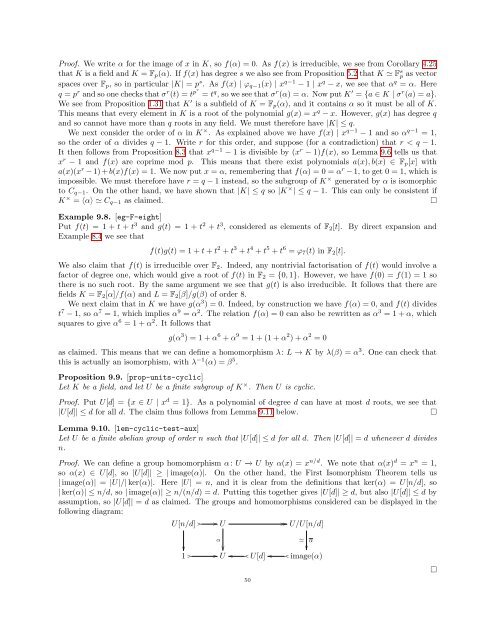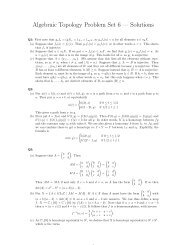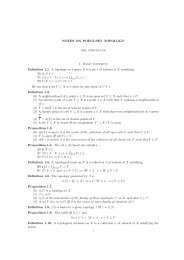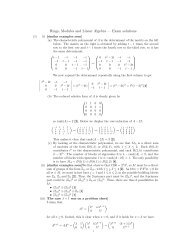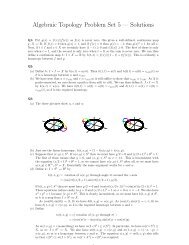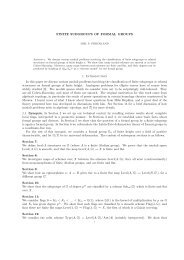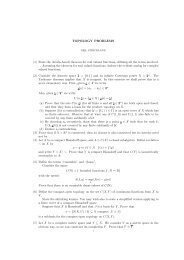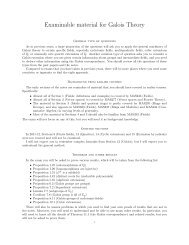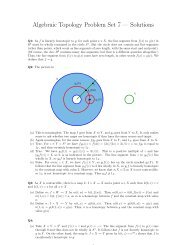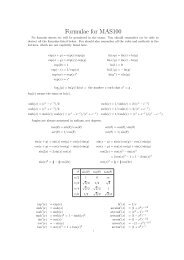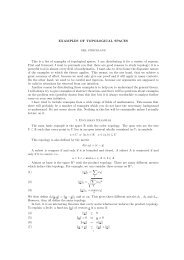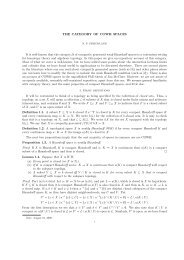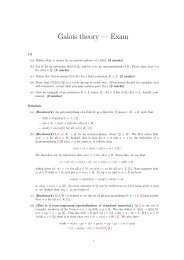fields and galois theory - Neil Strickland - University of Sheffield
fields and galois theory - Neil Strickland - University of Sheffield
fields and galois theory - Neil Strickland - University of Sheffield
You also want an ePaper? Increase the reach of your titles
YUMPU automatically turns print PDFs into web optimized ePapers that Google loves.
Pro<strong>of</strong>. We write α for the image <strong>of</strong> x in K, so f(α) = 0. As f(x) is irreducible, we see from Corollary 4.25<br />
that K is a field <strong>and</strong> K = F p (α). If f(x) has degree s we also see from Proposition 5.2 that K ≃ F s p as vector<br />
spaces over F p , so in particular |K| = p s . As f(x) | ϕ q−1 (x) | x q−1 − 1 | x q − x, we see that α q = α. Here<br />
q = p r <strong>and</strong> so one checks that σ r (t) = t pr = t q , so we see that σ r (α) = α. Now put K ′ = {a ∈ K | σ r (a) = a}.<br />
We see from Proposition 1.31 that K ′ is a subfield <strong>of</strong> K = F p (α), <strong>and</strong> it contains α so it must be all <strong>of</strong> K.<br />
This means that every element in K is a root <strong>of</strong> the polynomial g(x) = x q − x. However, g(x) has degree q<br />
<strong>and</strong> so cannot have more than q roots in any field. We must therefore have |K| ≤ q.<br />
We next consider the order <strong>of</strong> α in K × . As explained above we have f(x) | x q−1 − 1 <strong>and</strong> so α q−1 = 1,<br />
so the order <strong>of</strong> α divides q − 1. Write r for this order, <strong>and</strong> suppose (for a contradiction) that r < q − 1.<br />
It then follows from Proposition 8.3 that x q−1 − 1 is divisible by (x r − 1)f(x), so Lemma 9.6 tells us that<br />
x r − 1 <strong>and</strong> f(x) are coprime mod p. This means that there exist polynomials a(x), b(x) ∈ F p [x] with<br />
a(x)(x r − 1) + b(x)f(x) = 1. We now put x = α, remembering that f(α) = 0 = α r − 1, to get 0 = 1, which is<br />
impossible. We must therefore have r = q − 1 instead, so the subgroup <strong>of</strong> K × generated by α is isomorphic<br />
to C q−1 . On the other h<strong>and</strong>, we have shown that |K| ≤ q so |K × | ≤ q − 1. This can only be consistent if<br />
K × = 〈α〉 ≃ C q−1 as claimed.<br />
□<br />
Example 9.8. [eg-F-eight]<br />
Put f(t) = 1 + t + t 3 <strong>and</strong> g(t) = 1 + t 2 + t 3 , considered as elements <strong>of</strong> F 2 [t].<br />
Example 8.4 we see that<br />
f(t)g(t) = 1 + t + t 2 + t 3 + t 4 + t 5 + t 6 = ϕ 7 (t) in F 2 [t].<br />
By direct expansion <strong>and</strong><br />
We also claim that f(t) is irreducible over F 2 . Indeed, any nontrivial factorisation <strong>of</strong> f(t) would involve a<br />
factor <strong>of</strong> degree one, which would give a root <strong>of</strong> f(t) in F 2 = {0, 1}. However, we have f(0) = f(1) = 1 so<br />
there is no such root. By the same argument we see that g(t) is also irreducible. It follows that there are<br />
<strong>fields</strong> K = F 2 [α]/f(α) <strong>and</strong> L = F 2 [β]/g(β) <strong>of</strong> order 8.<br />
We next claim that in K we have g(α 3 ) = 0. Indeed, by construction we have f(α) = 0, <strong>and</strong> f(t) divides<br />
t 7 − 1, so α 7 = 1, which implies α 9 = α 2 . The relation f(α) = 0 can also be rewritten as α 3 = 1 + α, which<br />
squares to give α 6 = 1 + α 2 . It follows that<br />
g(α 3 ) = 1 + α 6 + α 9 = 1 + (1 + α 2 ) + α 2 = 0<br />
as claimed. This means that we can define a homomorphism λ: L → K by λ(β) = α 3 . One can check that<br />
this is actually an isomorphism, with λ −1 (α) = β 5 .<br />
Proposition 9.9. [prop-units-cyclic]<br />
Let K be a field, <strong>and</strong> let U be a finite subgroup <strong>of</strong> K × . Then U is cyclic.<br />
Pro<strong>of</strong>. Put U[d] = {x ∈ U | x d = 1}. As a polynomial <strong>of</strong> degree d can have at most d roots, we see that<br />
|U[d]| ≤ d for all d. The claim thus follows from Lemma 9.11 below.<br />
□<br />
Lemma 9.10. [lem-cyclic-test-aux]<br />
Let U be a finite abelian group <strong>of</strong> order n such that |U[d]| ≤ d for all d. Then |U[d]| = d whenever d divides<br />
n.<br />
Pro<strong>of</strong>. We can define a group homomorphism α: U −→ U by α(x) = x n/d . We note that α(x) d = x n = 1,<br />
so α(x) ∈ U[d], so |U[d]| ≥ | image(α)|. On the other h<strong>and</strong>, the First Isomorphism Theorem tells us<br />
| image(α)| = |U|/| ker(α)|. Here |U| = n, <strong>and</strong> it is clear from the definitions that ker(α) = U[n/d], so<br />
| ker(α)| ≤ n/d, so | image(α)| ≥ n/(n/d) = d. Putting this together gives |U[d]| ≥ d, but also |U[d]| ≤ d by<br />
assumption, so |U[d]| = d as claimed. The groups <strong>and</strong> homomorphisms considered can be displayed in the<br />
following diagram:<br />
U[n/d] U<br />
U/U[n/d]<br />
α<br />
1 U U[d]<br />
50<br />
≃<br />
α<br />
image(α)<br />
□


